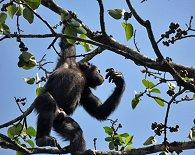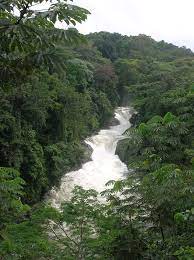
The chimpanzee, also simply known as the chimp, is a species of great ape native to the forests and savannahs of tropical Africa. It has four confirmed subspecies and a fifth proposed one. When its close relative the bonobo was more commonly known as the pygmy chimpanzee, this species was often called the common chimpanzee or the robust chimpanzee. The chimpanzee and the bonobo are the only species in the genus Pan. Evidence from fossils and DNA sequencing shows that Pan is a sister taxon to the human lineage and is thus humans' closest living relative. The chimpanzee is covered in coarse black hair, but has a bare face, fingers, toes, palms of the hands, and soles of the feet. It is larger and more robust than the bonobo, weighing 40–70 kg (88–154 lb) for males and 27–50 kg (60–110 lb) for females and standing 150 cm.
The Goualougo Triangle is a 100-square-mile (260 km2) region on the southern end of the Nouabale-Ndoki National Park, located in the Republic of Congo, in Central Africa. The northern Congo lowland forest ecosystem of the park is one of the most intact fauna habitats of its type in Africa. Populations of several endangered or threatened species are found here, including forest elephants, western lowland gorillas and a high density of common chimpanzees.

The Cross River gorilla is a critically endangered subspecies of the western gorilla. It was named a new species in 1904 by Paul Matschie, a mammalian taxonomist working at the Humboldt University Zoological Museum in Berlin, but its populations were not systematically surveyed until 1987.

De Brazza's monkey is an Old World monkey endemic to the riverine and swamp forests of central Africa. The largest species in the guenon family, it is one of the most widespread arboreal African primates. Aside from size, it can be differentiated from other cercopithecus monkeys by its orange diadem and white beard. Due to its cryptic nature, the species is not well documented in all of its habitats but has shown unique traits, such as pair-bonding and aggressive behavior towards other guenons.

The western gorilla is a great ape found in Africa, one of two species of the hominid genus Gorilla. Large and robust with males weighing around 168 kilograms (370 lb), the species is found in a region of midwest Africa, geographically isolated from the eastern gorilla. The hair of the western species is significantly lighter in color.

The wildlife of Cameroon is composed of its flora and fauna. Bordering Nigeria, it is considered one of the wettest parts of Africa and records Africa's second highest concentration of biodiversity. To preserve its wildlife, Cameroon has more than 20 protected reserves comprising national parks, zoos, forest reserves and sanctuaries. The protected areas were first created in the northern region under the colonial administration in 1932; the first two reserves established were Mozogo Gokoro Reserve and the Bénoué Reserve, which was followed by the Waza Reserve on 24 March 1934. The coverage of reserves was initially about 4 percent of the country's area, rising to 12 percent; the administration proposes to cover 30 percent of the land area.

The eastern chimpanzee is a subspecies of the common chimpanzee. It is native to the Central African Republic, South Sudan, the Democratic Republic of the Congo, Uganda, Rwanda, Burundi, and Tanzania.

The central chimpanzee or the tschego is a subspecies of chimpanzee. It can be found in Central Africa, mostly in Gabon, Cameroon, Republic of Congo and the Democratic Republic of Congo.

The western chimpanzee or West African chimpanzee is a Critically Endangered subspecies of the common chimpanzee. It inhabits western Africa, specifically Côte d'Ivoire, Guinea, Liberia, Mali, Senegal, Ghana, Guinea-Bissau, but has been extirpated in three countries: Benin, Burkina Faso, and Togo.

The Banyang-Mbo Wildlife Sanctuary is a wildlife sanctuary found in Cameroon. It was established in 1996. This site is 691.45 km2.

The Cross River National Park is a national park of Nigeria, located in Cross River State, Nigeria. There are two separate sections, Okwangwo and Oban . The park has a total area of about 4,000 km2, most of which consists of primary moist tropical rainforests in the North and Central parts, with mangrove swamps on the coastal zones. Parts of the park belong to the Guinea-Congolian region, with a closed canopy and scattered emergent trees reaching 40 or 50 meters in height.

Oba Hills Forest Reserve is a reserve in Iwo, Osun State, Nigeria, that covers about 52 square kilometres (20 sq mi) of hilly terrain with deep gorges. Oba Hill Forest Reserve is a small enclave encompassing three hills with a wide valley running in between. A large teak plantation is on its western side, covering about 12% of its total area beyond the hills; only coppices are left on the over-exploited plantation. According to a IUCN report from 2003, about 12% of the reserve had been planted with teak. Some chimpanzee sightings had been reported, and in 1999, a dead chimpanzee was offered for sale in a local market. A 2009 report said that almost all of the reserve had been converted to plantations and farms, with only two gullies remaining forest-covered. It is now believed that chimpanzees are nearly extinct in the reserve.

Ise Forest Reserve is located in Ekiti State, southwestern Nigeria, covering 142 km2, 5° 20.804'E to 5° 25.331'E longitude and 7°21.069'N to 7° 25.579'N latitude in the tropical hemisphere. The protected area is about 9 km to the southern part of the reserve along the Akure-Benin expressway from the Uso community in Ondo State. It remains one of the remaining forest fragments in southwest Nigeria, militated with intense human anthropogenic activities such as farming, logging, and hunting. However, they are considered to be integral and desirable components of forest ecosystems. It is one of the priority conservation areas for the endangered Nigeria-Cameroun chimpanzees in Nigeria with a degrading forest environment. The estimated terrain elevation above sea level is 366 meters. This is the chimpanzees' primary and most frequently recorded habitat in southwest Nigeria. It is also a habitat for about 661 species of butterflies and a large community of other animals and plants. It has been in the spotlight for nearly 20 years. One of the protected sites in the tropical hemisphere is the Ise Forest Reserve. Most of the forests in Nigeria, including protected areas, are under severe fragmentation. The result is that smaller fragments have fewer numbers of animals than the single larger fragments.
The Ngel Nyaki Forest Reserve, whose site is historically known as Majang, is situated on the Mambilla Plateau in North East Nigeria, covering 46 km2. It can be reached on foot from Yelwa village past the Mayo Jigawal, from where it is less than half an hour’s walk to the upper edge of the forest. The elevation ranges from 1,400 metres (4,593 ft) to 1,600 metres (5,249 ft). Ngel Nyaki was formally gazetted a local authority Forest Reserve under Gashaka - Mambilla Native Authority Forest order of April 1969, but presently it is under the management of the Taraba State Government and the Nigerian Conservation Foundation (NCF), with the Nigerian Montane Forest Project (NMFP) as a project partner.
The Mbe Mountains Community Forest is situated in southern Nigeria, and covers 86 km2.
The Afi Mountain Wildlife Sanctuary in Cross River State in southern Nigeria covers 104 km2 (40 sq mi). The wildlife sanctuary was founded in 2000 to provide refuge for endangered animal species, including the Cross River gorilla, the Nigeria-Cameroon chimpanzee, the drill and the gray-necked rockfowl.
The Mbam Djerem National Park is found in Cameroon. It was established in 2000 and covers 4234.78 km2.
The Bakossi National Park (BNP) is a protected area within the Bakossi Forest Reserve, created by a decree in early 2008. The park covers 29,320 hectares, and was justified on the basis of preserving plant diversification.
Deng Deng National Park is a national park in Cameroon. Established in 2010, it covers an area of 682.64 km2.













